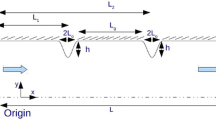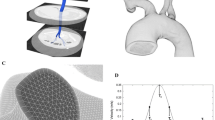Abstract
Atherosclerosis is known to be localised in arterial bends, bifurcations and branches. The exact mechanism is not known but it appears that the process starts due to haemodynamic changes. In general, the distribution arteries have relatively symmetrical bifurcations with varying angles and branch trunk area ratios. Several previously studied flow related characteristics were dependent on Reynolds number, angle of bifurcation and area ratios. The time dependence nature of the flow was not included in the above investigations. The equations of continuity and motion for two dimensional, time dependent flow of a homogenous, incompressible fluid through a horizontal, bifurcating rigid channel were therefore solved. The numerical method chosen to solve this problem was the marker and cell (MAC) method, which enabled the two velocity components and the pressure to be obtained directly. According to this system the flow field was divided into cells rather than points according to a prescribed scheme. It was found that a high shear stress zone developed at the daughter’s medial wall while at the lateral wall the fluid tends to follow the pressure gradient and the flow was reversed for part of the cycle. In addition, a high pressure zone which could attain values of twice the input pressure was found on the medial wall.
Similar content being viewed by others
References
Attinger, E. O. (1964). InPulsatile blood flow,Attinger,E. O. (Ed.) McGraw Hill, New York, 179.
Cheng, L. C., Clark, M. E., Robertson, J. M. andChao, N. H. (1978). Effects of flow division on bifurcation flow characteristic. First Mid-Atlantic Conference on Bio-Fluid Mechanics, Blacksburg, Virginia.
Crowe, Jr., W. J. (1969) Studies of arterial branching on models using birefringes. Ph.D. Thesis, University of Florida, Gainesville, Florida.
Ferguson, G. G. andRoach, M. R. (1972). Flow conditions at bifurcation as determined in glass models, with reference to the focal distribution of vascular lesions. InCardiovascular Fluid Dynamics,Bergel, D. H. (Ed.) Academic Press.
Fernandez, R. C., De Witt, R. J. andBotwin, M. R. (1976) Pulsatile flow through a bifurcation with applications to arterial disease.J. Biomech.,9, 575–580.
Friedman, M. H., O’Brien, V. andEhrlich, L. W. (1975). Calculation of pulsatile flow through a branch.Circ. Res.,36, 277–285.
Friedman, M. H., Bargeron, C. B., Deters, O. J. andMark, F. F. (1979). Haemodynamic measurements in human arterial casts in X11. International Conference on Medical and Biological Engineering, Jerusalem.
Lynn, N. S., Fox, V. G. andRoss, L. W. (1972) Computation of fluid dynamical contributions to atherosclerosis at arterial bifurcations.Biorheology,9, 61–66.
Roach, M. R. (1977) The effects of bifurcation and stenosis on arterial disease. In Cardiovascular flow dynamics and measurements.Hwang, N. H. C., Norman, N. A. (Eds.), University Park Press, Baltimore.
Rushmer, R. F. (1976). Cardiovascular dynamics. Saunders.
Texon, M. (1963). Role of vascular dynamics on the development of atherosclerosis. InAtherosclerosis and its origin.Sandler, M. andBourne, G. H. (Eds.) New York Academic Press, 167–195.
Vawter, D., Fung, Y. C. andZweifach, B. W. (1974) Distribution of blood flow and pressure from a microvessel into a branch.Microvascular Res.,8, 44–52.
Welch, J. E., Harlow, F. H., Shannon, J. P. andDaly, B. J. (1966) The MAC Method—a computing technique for solving viscous, incompressible, transient fluid-flow problems involving free surfaces. Los Alamos Scientific Laboratory, Los Alamos.
Bibliography
Aroesty, S. andGross, J. F. (1971a). Pulsatile flow in small blood vessels: Casson theory. R-767-NIH, Rand.
Aroesty, J. andGross, J. F. (1971b). The mathematics of pulsatile flow in small vessels: Casson theory. R-768-NIH, Rand.
Browne, L. W. B. (1978). The MAC technique in numerical simulation of fluid motion. North-Holland, Amsterdam.
Burton, A. C. (1965). Physiology and biophysics of the circulation. Chicago Year Book Medical Publishers, 50–57.
Caro, C. G., Fitzgerald, J. M. andSchroter, R. C. (1969) Arterial wall shear and distribution of early atheroma in man.Nature,223, 1159–1161.
Caro, C. G., Fitzgerald, J. M. andSchroter, R. C. (1971). Atheroma and arterial wall shear observation, correlation and proposal of a shear dependent mass transfer mechanism for atherogenesis.Proc. R. Soc. Lond. Series B,177, 109–159.
Clark, M. E., Robertson, J. M. andCheng, L. C. (1977). Interactive and non-uniform unsteady physiological flows by finite difference transforms. Proc. of Symposium on computer methods in engineering. University of California,1, 497–506.
Dintenfasse, L. (1962) Thixotropy of blood proneness to thrombus formation.Circ. Res.,11, 133–139.
Ehrlich, L. W. (1964). Digital simulation of periodic fluid flow in a bifurcation.Computers and Fluids,2, 237–247.
Fernandez, R. C. (1972) Pulsatile flow through a bifurcation with application to arterial disease. Ph.D. Thesis, University of Toledo, Toledo, Ohio.
Fox, J. A. andHugh, H. E. (1966). Localisation of atheroma: theory based on boundary layer separation.Br. Heart J.,28, 388–399.
Fry, D. L. (1969). Certain chemorheologic considerations regarding the blood vascular interface with particular reference to coronary artery disease. InResearch on acute myocardial infarction.Bondurant, S. (Ed.), New York, American Heart Association, Inc.
Gessner, F. B. (1973). Hemodynamic theories of atherogenesis.Circ. Res.,3, 259–266.
Haust, M. D. andMore, R. H. (1972). InDevlopment of modern theories on the pathogenesis of atherosclerosis.Wissler, R. W., Geer, J. C. andKaufman, N. (Eds.), Baltimore, Williams & Williams Co.
Junquiera, L. C. (1977). Basic histology. Lange Medical Publications.
McDonald, D. A. (1974). Blood flow in arteries. Arnold Publishers. London.
Merrill, E. W., Gilliland, E. R., Lee, T.S. andSaltzman, E. W. (1966) Blood rheology: effect of fibrinogen deduced by addition.Circ. Res.,13, 437–446.
Roache, P. J. (1972) Computational fluid Mechanics. Harmosa Publishers, Albuquerque.
Schlichting, H. (1968) Boundary layer theory. McGraw-Hill, New York.
Wesolowsky, S. A., Fries, C. C., Sabini, A. M. andSawyer, P. N. (1965). Significance of turbulence in hemic systems and in the distribution of the atherosclerotic lesion.Surgery,57, 155–162.
Author information
Authors and Affiliations
Rights and permissions
About this article
Cite this article
Einav, S., Stolero, D. Pulsatile blood flow in an arterial bifurcation: Numerical solution. Med. Biol. Eng. Comput. 25, 12–17 (1987). https://doi.org/10.1007/BF02442814
Received:
Accepted:
Issue Date:
DOI: https://doi.org/10.1007/BF02442814




